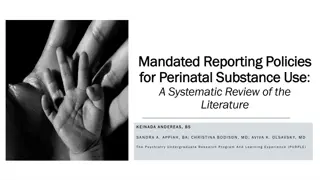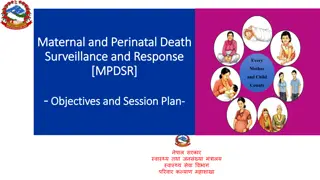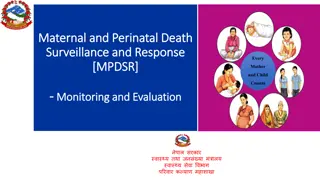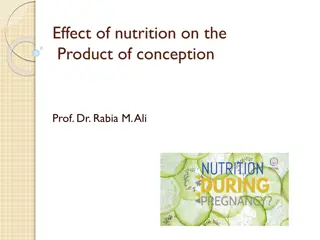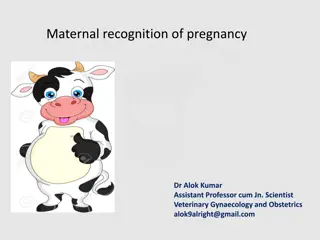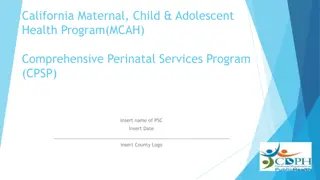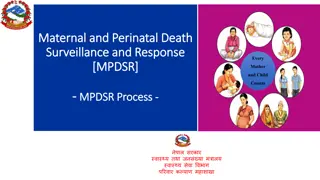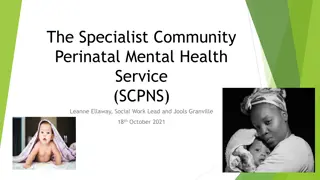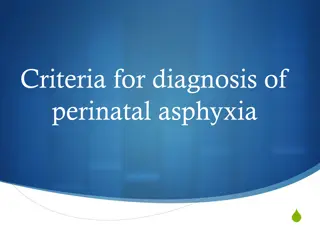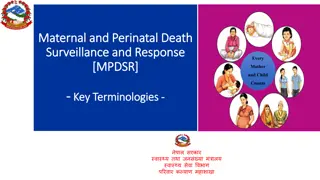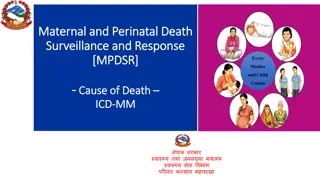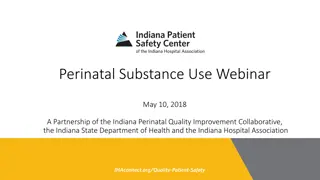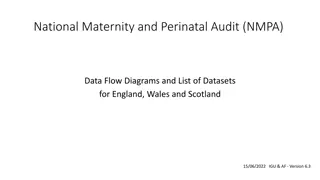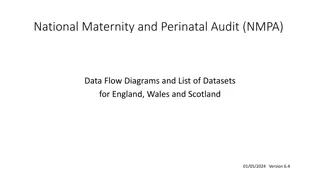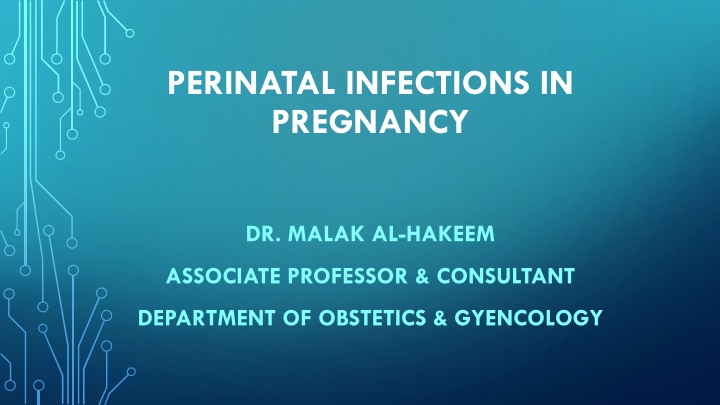
Perinatal Infections in Pregnancy by Dr. Malak Al-Hakeem
Explore the different aspects of infectious diseases in pregnancy that may lead to neonatal and maternal morbidity and mortality. Learn about viral, bacterial, and parasitic infections, their impact on pregnancy, methods of transmission, diagnosis, treatment, and prevention. Delve into specific infections such as AIDS, Hepatitis, Toxoplasmosis, and more.
Download Presentation

Please find below an Image/Link to download the presentation.
The content on the website is provided AS IS for your information and personal use only. It may not be sold, licensed, or shared on other websites without obtaining consent from the author. If you encounter any issues during the download, it is possible that the publisher has removed the file from their server.
You are allowed to download the files provided on this website for personal or commercial use, subject to the condition that they are used lawfully. All files are the property of their respective owners.
The content on the website is provided AS IS for your information and personal use only. It may not be sold, licensed, or shared on other websites without obtaining consent from the author.
E N D
Presentation Transcript
PERINATAL INFECTIONS IN PREGNANCY DR. MALAK AL-HAKEEM ASSOCIATE PROFESSOR & CONSULTANT DEPARTMENT OF OBSTETICS & GYENCOLOGY
AIM : TO STUDY OF THE DIFFERENT ASPECTS OF INFECTIONS DISEASES IN PREGNANCY WHICH CAN CAUSE NEONATAL AND MATERNAL MORBIDITY AND MORTALITY OBJECTIVES: 1. Identify different infectious disease which can occur in pregnancy 2. Study their incidences, diagnosis, mode of transmission, course of the diseases, treatment and prognosis. 3. Effect of these infectious diseases on pregnancy and impact of pregnancy on the course of the disease. 4. Prevention.
A - VIRAL INFECTIONS AIDS (Acquired immunodeficiency syndrome) Human parovirus B19 infection Rubeola (Measles) Rubella ( German Measles) Cytomegalovirus Varicella Zoster Hepatitis Herpes Simplex
II - BACTERIAL INFECTIONS Urinary tract infections Group B Streptococci Listeriosis Gonorrhoea Tuberculosis Chlamydia Spirochete infections III -PARASIOTIC INFECTION ToxoplasmosisI
I - VIRAL INFECTION A. ACQUIRED IMMUNODEFICIENCY SYNDROME (AIDS) HIV is an RNA retrovirus Modes of infection via:- Infected Blood. Infected body sections. Maternal infant spread.
I - VIRAL INFECTION A. ACQUIRED IMMUNODEFICIENCY SYNDROME (AIDS) INCIDENCE: In USA about 78% of newly diagnosed women acquired through heterosexual intercourse, and 20% via contaminated needle and remaining case by maternal-child transmission. 70% of HIV infected women were diagnosed between 25 - 44 years old .
LABORATORY DIAGNOSIS OF HIV INFECTION Enzyme linked immunosorbent assay (ELISA) Western blot Immunofluorescent assay Indirect serology with capture ELISA (p24 antigen test) Direct tissue culture indentification HIV DNA polymerase chain reaction
Newborn Diagnosis:- Newborn delivered to HIV infected mother will acquire HIV IgG antibodies via transplacental passage. They remain IgG antibodies positive for 18 months. Therefore, IgG testing antibodies are not useful in diagnosing HIV in early infancy.
Diagnosing HIV in infancy is made using : 1.Polymerase chain reaction. 2. HIV culture. 3. P24 antigen test. If 2 or more tests are positive, infection is confirmed. It may need up to 4 months for the tests to be positive, depending on the timing of neonate infection ( in utero VS delivery infection).
COURSE OF THE DISEASE:- Asymptomatic period (average is 10 years) in adults Destruction of T4 cells by HIV and reversal of T4/T8 ratio to < 1. General illness symptoms (malaise, fatigability, anorexia, fever, weight loss, nausea) Secondary cancers (Kaposi s sarcoma, non-Hodgkins s lymphoma) Dementia and neuropathies Opportunistic infection:- Pneumocystis carinii pneumonia PCP Tuberculosis Cryptococcal meningitis Cytomegalovirus retinitis Severe herpes
IMPACT OF PREGNANCY ON THE DISEASE:- Pregnancy does not accelerate the course of HIV infections They are at higher risk for developing opportunistic infections, postpartum infections, antepartum urinary tract infections and sexually transmitted diseases. No direct effect on neonatal outcome i.e risks of fetal growth restriction, preterm labor or premature rupture of membranes are not increased. No evidence that HIV infection can result in fetal structural anomalies.
VERTICAL TRANSMISSION: ( transmission of HIV from infected mother to her infant ) - Occur in 20-30%. Accounts for 99% of HIV infected children. - May occur in : 1. Utero i.e. transplacental. - 2. Intrapartum. - 3. Postpartum. - > 50% of transmission occurs near or during labor.
- No evidence indicates that mode of delivery affects transmission rates. - Cesarean Section done for obstetrics reasons. - However: Vertical transmission increase in: - Mother with recent HIV infection - Preterm labor. - Advanced maternal HIV disease - Breast-feeding increase vertical transmission by 5-20%. - Vertical transmission decrease from 25 50% by giving antiviral Zidovudine (AZI) during pregnancy, labour and to the neonate.
CARE OF PREGNANT HIV-INFECTED MOTHER Team Work: Obstetrician Pediatrician medical physician( infectious diseases) History Risk factors . Medical History : weight loss, T.B.
CARE OF PREGNANT HIV-INFECTED MOTHER Examination: Oral cavity (thrush, leukoplakia Fundus - Retenitis LN, liver, spleen Pre rectal area (herpes) Complete neurological exam.
INVESTIGATIONS: CBC differential count Platelets Liver function test T4, cell, T4 / T8 ration Screen for other infectious diseases, e.g. T.B, Rubella, syphilis, toxoplasmosis etc. Pneumocystis, carinii pneumonia (PCP) Cervical culture for chlamydia, gonorrhea and yeast. Prohylaxis against (PCP) with trimethoprim-sulpfamethoxazole (Bactrim) is indicated if the mother T4 below 200 cells/ l. Invasive procedures such as (amniocentesis, fetal scalp electrode etc.) should be avoided if possible.
II.RUBEOLA (MEASLES) Clinical Manifestations:- Caused by a paramyxovirus. Spread by direct or indirect contact with respiratory secretions . It is communicable from 4 days before to 7 days after the onset of the rush. Incubation period is 10 days.
DIAGNOSIS:- Diagnosis in primarily by clinical presentation. Lab. Identification of Rubella IgM antibodies 5-10 days after the onset of the rash.
IMPACT ON FETUS AND PREGNANCY:- Most women get immune either by vaccination or solid immunity. If the mother get infected in pregnancy, fetus can get infected by trnasplacental viral transmission. Measles vaccine is a live attenuated virus, therefore it is contraindicated in pregnancy. MATERNAL INFECTION: rate of spontaneous abortion Preterm labour and low birth weight Post natal acquired measles is Usually mild disease.
RUBELLA (GERMAN MEASLES):- Clinical Manifestations It is caused by RNA togavirus transmitted through the respiratory tract. Incuabation period 14-21 days Diagnosis: Best by serological test. IgM appear at the rash onset and disappears by 4-8 weeks. IgG appear at the rash onset and stay life long. Hemaglutination inhibiting antibodies and culture to isolate the virus in acute phase. Diagnosis of perinatal rubella infection:- detection of IgM in cord blood . Detection of IgG in infant after 6 months of age.
IMPACT OF RUBELLA ON PREGNANCY:- The disease course is not altered by pregnancy The gestational age at which the infection occurs has the greatest impact on the fetus. Fetal infection can cause :- Normal baby Spontaneous abortion Congenital rubella syndrome (CRS) 1sttrimester infection 2ndor third trimester carries 25% risk of (CRS) infection carries < 1% risk of (CRS) 50% risk in first 4 weeks
CONGENITAL RUBELLA Central nervous system involvement:- Microcephally Panencephalitis Brain calcifications Psycomotor retardation Symmetrical intrauterine growth restriction Congenital deafness (detected after age 1 year) Hepatitis Cardiac malformation: Patent ductus arteriosus Pulmonary artery hypoplasia Thrombocytopenic purpura Hepatitis Thrombocytopenic purpura Cataracts Retinopathy Microphthalmia Eye lesions:- Others:- Hepatosplenomegaly
Rubella Screening should be done in pregnancy by testing maternal serum IgG level. Non immune women should be vaccinated in the immediate postnatal period. ( Avoid contact with infected people during pregnancy) Rubella vaccination is alive attenuated virus, therefore contra-indicated in pregnancy. Antibody titers should be followed up as 20% will fail to develop antibodies Rubella is not a contraindication to breast feeding
III. HEPATITIS B INFECTION :- Caused by DNA virus. Transmitted via blood and body secretions e.g., (milk, vaginal secretions, semen, saliva) and across the placenta. Infection can be asymptomatic or expressed as acute hepatitis. Infected population can go on to either :- Chronic active Persistent hepatitis
IMPACT ON PREGNANCY:- The course of disease is not altered by pregnancy. Chronic active hepatitis is associated with : Neonatal death Low birth weight, Risk of prematurity.
IMPACT ON PREGNANCY:- If Mother is positive only to HBsAg develop acute infection at birth newborn has 10% risk to While if mother is +ve to both HBsAg and HBeAg the infants risk to 70-90%
MANAGEMENT:- 1. Liver Function test and complete hepatitis test markers should be done. 2. To vaccinate her husband and household members. 3. Avoid fetal scalp electrodes during labor, to avoid fetal infection. 4. Fetal transmission occur during labor, and post-natal , therefore hepatitis immune globulin and hepatitis vaccine both should be given to the fetus soon after delivery.
IV. HERPES SIMPLEX:- - DNA virus - Sexual transmitted disease, highly contagious. - Transmitted by intimate mucocutaneous contact. - 90% caused by Herpes Simplex virus type II and 10% by type I.
CLINICAL MANIFESTATIONS:- Vulvar pain tenderness. Inguinal lymphadenopathy. Generalized malaise and low-grade fever. Vesicle appear on the perineal skin, vulva and vestibule
IMPACT ON PREGNANCY:- Primary Genital Herpes. Primary Herpes in pregnancy have increased risk of obstetric and neonatal complications. Maternal infection has been associated with increased risk of spontaneous abortions, IUGR and preterm labor. Recurrent Herpes. 4% of infants born to mothers with recurrent infection at the time of delivery have Herpes infection.
IMPACT ON PREGNANCY:- Neonatal herpes:- Infection acquired by the infant via:- 1 passage through an infected birth canal . 2 ascending infection in 90% of cases. 3 Transplacental infection. 4 close contact with an infected individual after delivery
MANAGEMENT IN PREGNANCY:- Women with a prior history of herpes should be allowed to deliver vaginally if no genital lesions are present at the time of labor.
MANAGEMENT IN PREGNANCY:- Patients with active lesions, either recurrent or primary at the time of labor should be delivered by caesarean section. Mothers may breast-feed as long as no lesions are present on the breasts.
B. BACTERIAL INFECTIONS - I. Urinary tract infections (UTI) - Occur more frequently in pregnancy and puerperium, due to both hormonal (progesterone) and mechanical factors that urinary stasis. - Ureteral tone and mobility, dilatation of the ureters and renal pelvis. - UTI in pregnancy could be symptomatic or asymptomatic
I. URINARY TRACT INFECTIONS (UTI) - Asymptomatic Bacteriuria defined as the presence of 100,000 organisms/ml in mid stream urine specimen from an asymptomatic patient. - E-Coli is isolated in 60% of pt. with asymptomatic bacteria:- - Other organisms include: Proteus mirabilis, Klebsiella pneumonia, group B streptocooci
CONTINUE: If asymptomatic bacteria is left unrelated cystitis or pyelonephritis. Management of UTI :- Urinalysis (Bacteriuria, Pyuria, and/ or hematuria) Urine Culture and sensitivity Treat patient on outpatient basis. Acute pyelonephritis :- is manifested by flank pain, fever, rigors, nausea, vomiting and dehydration. A rare complication is septic shock and adult respiratory syndrome Premature uterine contraction may frequently occur 20% will develop acute
MANAGEMENT OF ACUTE PYELONEPHRITIS :- Hospitalization IV hydration IV antibiotics Monitoring for preterm labor
II.GROUP B STREPTOCOCCI (GBS):- GBS can be transmitted to genital tract by :- 1 vaginal carriers in 15-40% of cases. 2 Fecal contamination (as GIT is the major reservoir). 3 sexually transmited from a colonized partner. DIAGNOSIS: GBS are considered normal flora (in GIT, vaginal, cervix, throat, skin and urine of healthy individuals) - GBS grow on routine bacteriologic media. - Selective blood Agar or Todd-Hewitt both improve the detection rate.
IMPACT OF GBS ON PREGNANCY Highest vertical transmission rates occurring in women with heavy vaginal colonization. Vertical transmission occur at delivery. Other risks factors for transmission includes:- .Pre-term labor , low birth weight, preterm rupture of membranes, prolonged rupture of membranes (greater than 12 hr before delivery), intrapartum fever and a history of previously delivering an infected infant.
GBS NEONATAL INFECTION:- IT IS TWO TYPES: 1. Early-onset GBS infection :- . Is characterized by its rapid onset and fulminant course, with presentation typically within the first 48 hours of newborn life. . Affected infant presents with respiratory distress and pneumonia, meningitis, Septicemia, shock, and death. . The mortality rate from early onset disease is 50%.
2. Late-onset Neonatal GBS infection:- . linked to a nosocomial source in the nursery, occurs after the first week of newborn life. Treating carriers in labor and nursery will reduce the rate of transmission to the infant.
III. CHLAMYDIA:- Associated with incidence of premature labor, premature rupture of membranes and late postpartum endometritis. The neonates may acquire the organism at delivery and develop conjunctivitis, pneumonia and otitis media. High risk groups include adolescents,, single mothers, women of lower socioeconomic status, patients with multiple sexual partners and those with other sexually transmitted diseases.
DIAGNOSIS:- Culture on cyclohexamide-treated McCoy cells is the most sensitive method of diagnosis, but is costly, slow and limited in availability. Rapid antigen detection tests such as Chlamydiazyme or MicroTrak are reliable, inexpensive and rapid.
TREATMENT:- Erythromycin is the therapy of choice in pregnancy. If erythromycin cannot be tolerated, amoxicillin is alternative. Sexual contacts should receive empirically treatment. Erythromycin is also the drug of choice for the neonate if pneumonia or otitis media develops.
IV. PARASITIC INFECTIONS:- TOXOPLASMOSIS:- Toxoplasmosis is a systemic disease caused by the protozoan Toxoplasma gondii. 15% - 40% of women of reproductive age have antibodies (IgG) to toxoplasmosis, therefore they are immune.
TOXOPLASMOSIS:- Most infections are subclinical. Occasionally, toxoplasmosis presents as Mononucleosis-like syndrome. Infection is acquired by ingesting undercooked meat or unpasteurized goat s milk or by exposure to feces from an infected cat.
IMPACT ON PREGNANCY:- The risk of transmission to the fetus is 15% in the first trimester, 25% in the second trimester and 65% in the third trimester. However, the severity of fetal infections is greatest with first trimester infection. The classic triad of hydrocephalus, intracranial clacifications and chorioretinitis is rarely seen. Approximately 75% of infected infants are asymptomatic at birth.
DIAGNOSIS:- Diagnosis by serologic testing for both IgG and IgM. Diagnosis is confirmed by a positive finding of IgM or a fourfold rise in IgG titer in sequential samples obtained 2 to 3 weeks apart. TREATMENT: - Toxoplasmosis is a self-limiting disease. - However to prvent fetal risks, spiramycin is used for treatment in the absence of fetal infection . - If fetal infection is identified, therapy with pyrimethamine and Sulfadiazine plus folinic acid should be given to reduce the severity of fetal damage.

